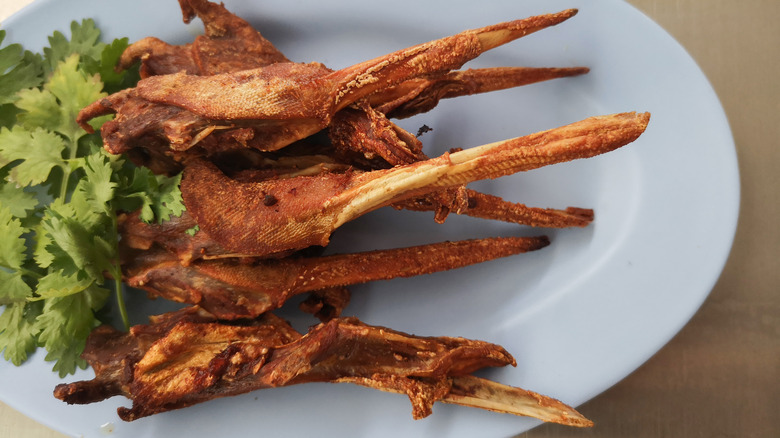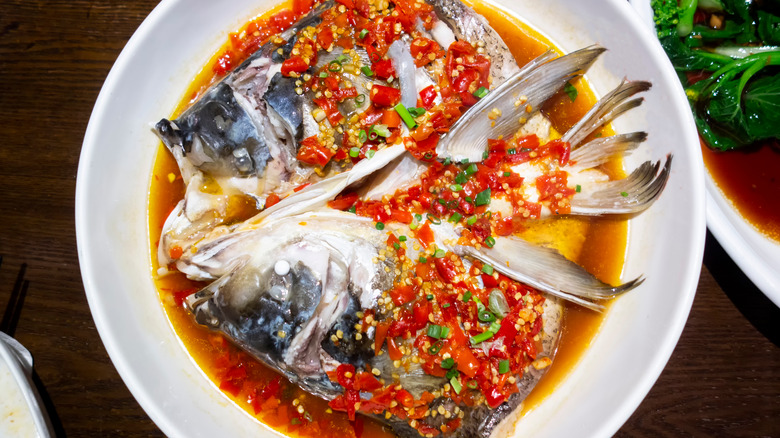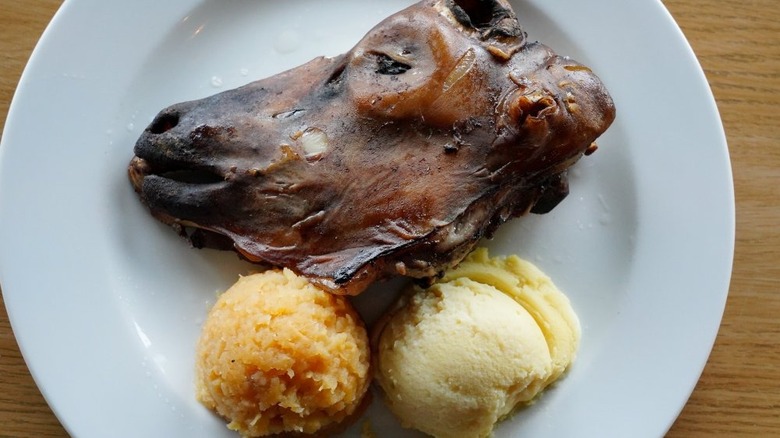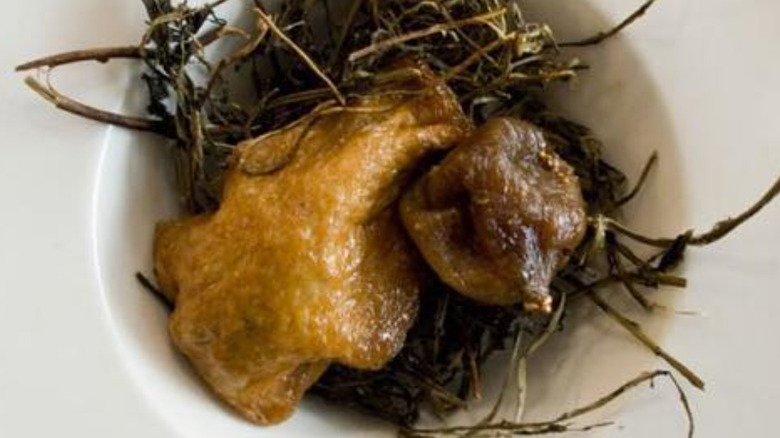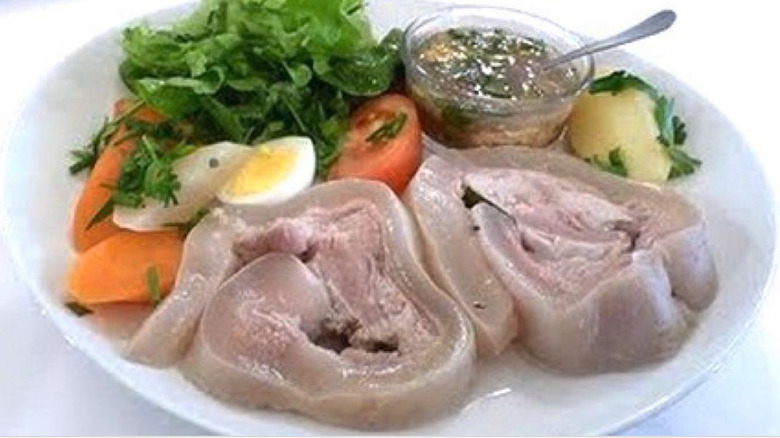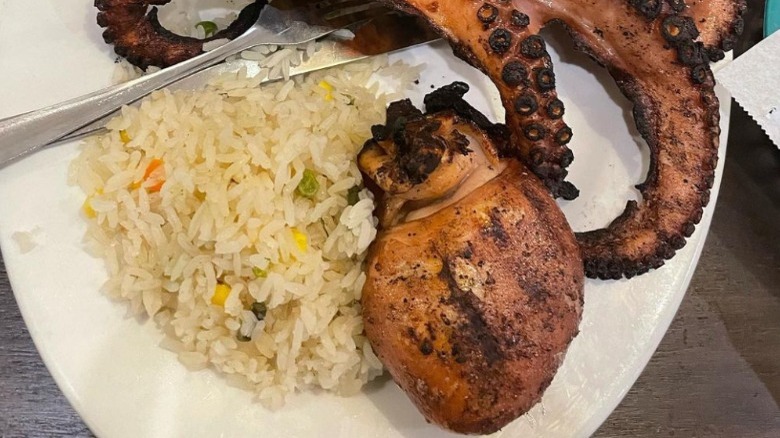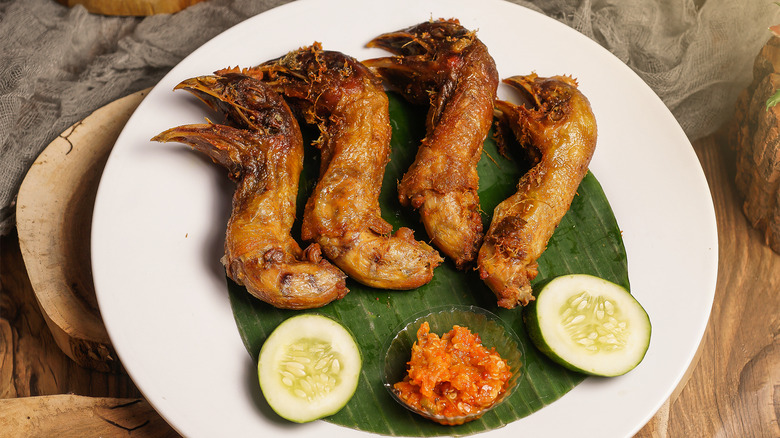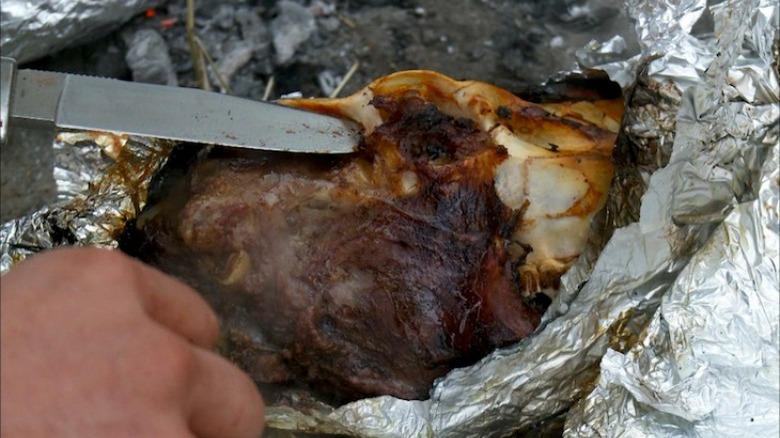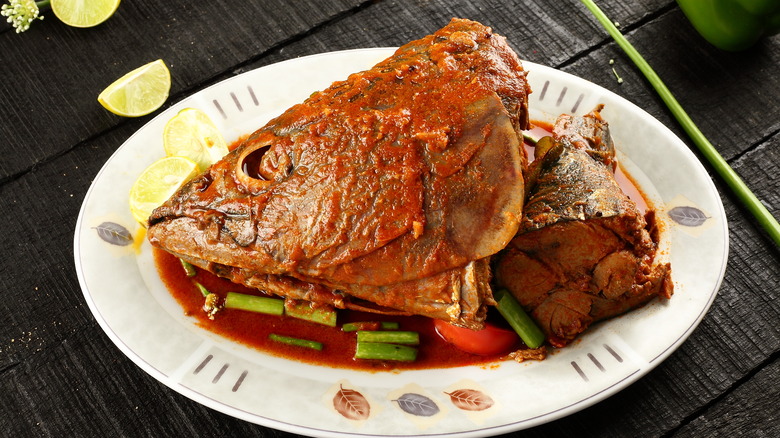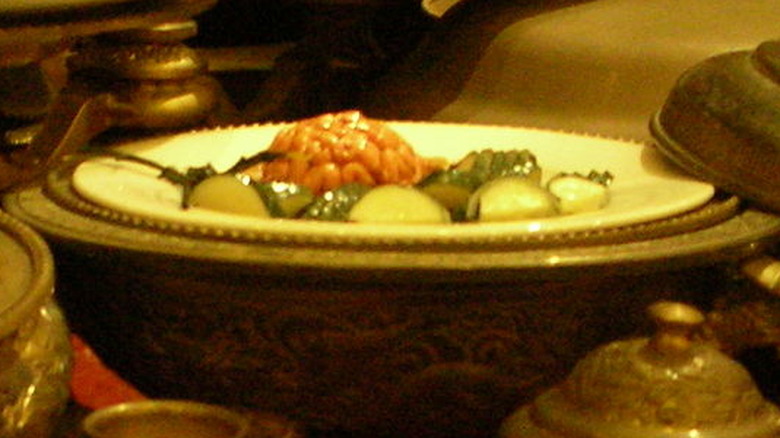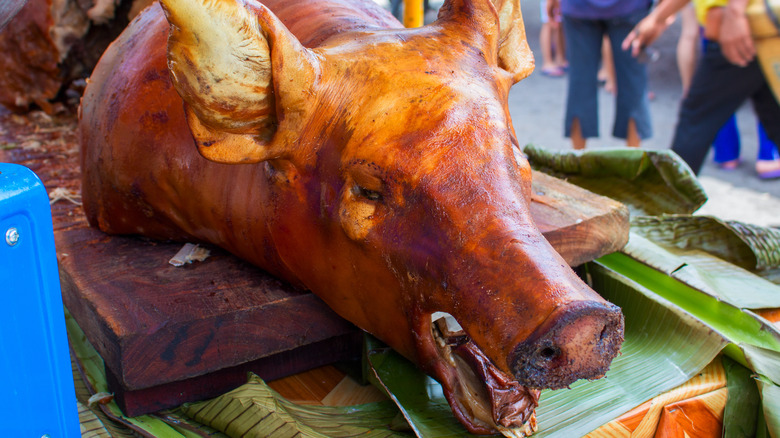These Countries Prove You Should Be Eating Animal Heads
Some people say they won't eat "food with a face" (per NPR). Over on the other end of the spectrum are those who not only enjoy eating animals, but who also relish the opportunity to eat the heads of some, given the right opportunity. Indeed, the heads of most animals whose flesh we readily consume are not merely edible, but, more often than not, quite delectable (via HuffPost). Think about all that tender, juicy, deeply marbled flesh, packed among delicate bones and collagen-rich connective tissue, blanketed by a layer of flavorful fat and crispy skin. Let's not forget about all the rich and velvety organ meats that you'll find within the skulls of many animal heads.
In fact, you may already be enjoying some of these, including beef tongue and beef cheeks, which are delicacies in various cuisines, per Nom Nom Paleo. If you've ever eaten a lobster, you've probably had the opportunity to tuck right into an animal's head, per Maine Lobster Now. If you're a fan of hot dogs, then there's a really good chance you've already eaten meat from a hog's head without even realizing it (via Insider). The bottom line is it's not all that uncommon for humans to consume animal heads, and you may even do so yourself. Moreover, and in all of these countries, it's perfectly normal and considered quite a treat. What may surprise you, however, is which animal heads are popular in certain countries.
China: fish, lamb, duck, and rabbit heads, and more
You've probably seen whole fish, including the head, on dinner plates in Chinese-American restaurants. If it's dinner in Japan, however, the fish head itself may be the main attraction. In Mainland China, the eating of animal heads is perfectly normal — it's a part of everyday life, possibly even rather boring for some, per People's Daily Online. The heads of any number of fish, not to mention shellfish such as crayfish and shrimp, are just some of the many heads of animals that are consumed and thoroughly enjoyed in this country.
Other animal heads that are considered delicacies in China are lamb's head, which you'll find boiled in a classic Beijing dish called "baishui yangtou," among others. While in Kaifeng, intrepid food adventurer Trevor James tried boiled lamb head and particularly enjoyed the way the eyeball gave way and then burst when he bit into it (via Cooking Shows). Rabbit head is also enjoyed throughout China. In the Sichuan Province, where the dish originated, spicy rabbit head is a popular street food. In Dongsheng, deep-fried duck heads are also a popular street food. According to The New York Times, most edible animals' heads are enjoyed in China, with the most popular being fish, duck and rabbit, followed closely behind by pig, goat, and dog.
The Arctic: where the Inuit people eat all the animal heads
For the Inuit people of Alaska, Canada, and Greenland, eating an animal's head is as normal as eating any other part, per The Canadian Encyclopedia. In fact, in the Inuit community, it would be considered wasteful, if not disrespectful, to discard any part of any animal that has been hunted. What's not consumed as food can be used for clothing, heating, or the making of tools. Of course, the head of most animals will inevitably be consumed because, as noted above, the head contains some of an animal's most tender, juicy, and flavorful flesh, unburdened as that flesh has been by the necessity of bearing weight. Furthermore, the flesh of the head and its contents are rich in nutrients and energy, including protein, dietary fat, essential minerals, and vitamins (via Culinary Schools).
Animals hunted by the Inuit community that are consumed head and all include the polar bear and the seal. A whole seal can be stuffed with 500 small birds (whole, of course) and then fermented underground for 1 year before being enjoyed. This traditional Inuit dish is called "kiviak." It might sound surprising when you consider that throughout the US and Europe (which are adjacent to and on these same continents with many of the Inuit people), it is illegal to import seal meat, according to Food Republic. However, an exception is made for the Inuit people.
In Iceland, sheep's head is one of the national dishes
In an interview with Mashed, comedian Jim Gaffigan said the strangest food he ever ate was sheep's head. Weird as it may have seemed to Gaffigan, sheep's head is consumed in many countries. In South Africa, it's roasted and served whole. In Morocco, it's braised and served with flatbread, per Meridian. Gaffigan got his first taste of sheep's head in Iceland, where the tradition is to serve a sheep's head as a dish known as "svið," according to Atlas Obscura, The dish typically consists of the whole sheep's head, including its fur, and it's usually sliced in half.
Although animal brains are eaten in a number of cultures, including in Vietnam, the brain is removed when making svið. The half-head is then placed in a pot to boil until tender. Afterward, it's served with either mashed turnips or mashed potatoes. Svið is typically on buffet tables during Iceland's midwinter festival, which takes place from late January through late February, per Icelandair. Although the traditional presentation is to serve half a sheep's head intact on the plate with the eye staring up, not everyone is fond of the aesthetic. Some get their fix of svið in the form of "sviðasulta," which is a type of head cheese made from the boiled half sheep's head, according to DelightedCooking.
United Kingdom: everything but the beak of this songbird
The ortolan is a tiny songbird that spends the balmier months in Europe and Asia, and then winters in warmer climes — but not before gorging until it has built up a thick, warm coating of fat. Meanwhile, foodies throughout Britain rub their hands together in anticipation of the decadent dish known as "ortolan bunting." Ortolan bunting is a whole ortolan, one that was caught during its fattest months, according to Atlas Obscura. After its capture, the ortolan is encouraged to gorge itself once again until it doubles in size. It's then drowned in Armagnac, which serves also as a marinade. Afterward, it's roasted, plucked, and served piping hot and whole — head, feet, and all, albeit not the beak — to diners shrouding their faces beneath a towel.
A towel is considered a matter of "good etiquette" in the sense that eating something so decadent as a songbird that's been tricked into ill health before being drowned in brandy, could be viewed as. well, improper, according to the Telegraph. Because the ortolan has become endangered, the trapping of this bird is illegal in some countries. In addition, ortolan trade is banned in the European Union, and the dish has been illegal in its actual country of origin, France, since 1999 (via CNBC). Lucky for President Francois Mitterrand, it was still legal when he enjoyed it quite deliberately as his last meal on Earth in 1996 (via Esquire).
Mexico, France, and Italy all have calf heads in common
"Barbacoa" is Spanish for "barbecue," but in Mexico, it's understood to be a particular kind of barbecue — one that is primarily about the calf's head and its contents, per Longreads. "When I was a kid, the barbacoa that emerged was composed of three parts: cachete (cheek), lengua (tongue), and mixta (a mixture of brains, lips, eyeballs, and probably, if you're not careful, ears," wrote National Book Award finalist, Domingo Martinez, in a story published in Texas Monthly (via Longreads). Today, barbacoa is usually served sliced (sans brains) as a delectable street food taco.
In France, calf heads are enjoyed as a high-end delicacy, according to FrenchCrazy. The site describes "la tête de veau," as it is called in France, as the tenderest of meat, including the flesh of the face, the tongue, and the brain. To make la tête de veau, the calf's head is boiled for as long as it takes to render the meat, tender, and the skin, gelatinous, according to TasteAtlas. It's then sliced thickly and served with vegetables and a light herbaceous sauce known as "ravigote."
In Italy, the calf's head is a traditional dish on Christmas. It also finds its way onto tables throughout the UK and parts of Europe. It's eaten in the US as well, like many other animal heads, which we will be getting into in just a bit.
South Korea: when you order octopus, expect to be served the head
Octopus is a staple of South Korean cuisine, according to the Los Angeles Times. The publication notes that in 2013, octopus' popularity was exceeded only by kimchi, noting that the octopus fishing industry accounted for as much as $35 million of South Korean commerce. That shouldn't be surprising to the many who are already enjoying grilled octopus at restaurants across the US. What might surprise you, though, is that the tradition in South Korea is to serve the octopus head with its legs.
Not only is the octopus head known for being nutritious, but it's also believed by some to deliver aphrodisiac properties. Aside from that, it's just plain meaty and delicious, according to the many who enjoy octopus heads in the form of "nakji." It's made with baby octopuses, including the heads, and is popular at sporting events (the way Cracker Jack is popular at baseball stadiums in the US). Octopus head is also enjoyed raw and even live, in a dish called "sannakji," per the Los Angeles Times.
Although South Korea's octopus supply was found to be tainted with unacceptable levels of cadmium in the early 2010s, the advice given at the time was to limit consumption to 2 octopus heads per day, per The Independent. Further, a 2018 study published in the Bulletin of Environmental Contamination and Toxicology suggests that there is no current danger in enjoying any part of the octopus with abandon.
Indonesia, The Philippines, Thailand, and Myanmar: Chicken heads
In Indonesia, where if an animal is edible, its head is probably on the menu as well, locals know something about chicken that many around the world are not yet aware of: one of the best parts of the chicken to eat isn't the breast, nor is it the delectable back. The part that is often fought over among families who know it's both decadently delicious (per ChefTalk) and surprisingly nutritious (per HuffPost Life) is the head — beak and all. You'll find many people in the world, particularly in Southeast Asia, who will swear that it's the most exquisite chicken part that you're probably not eating.
Anthony, the travel writer behind The Travel Tart blog, may not have been brave enough to partake when he had the opportunity while traveling through Indonesia. However, that doesn't mean he wasn't missing out on a crispy, juicy, succulent epicurean adventure. For those who already enjoy a nice roast chicken neck, the neck is sometimes served right along with the head. In the Philippines, chicken heads are threaded — three or so at a time — onto a skewer, and prized as crisp, satisfying street food. Chicken heads are also enjoyed by many in Thailand and Myanmar, among other Southeast Asian countries.
Canada and various other countries wouldn't think twice about eating a deer head
If you're someone who prefers to eat only what you kill, then perhaps you've already experienced the pleasures of roasting the head of a deer, which is not all that unusual for deer hunters (per MeatEater Cook and Aligning With Nature). In the interest of environmental ethics and conservation, it's probably preferable to err on the side of doing so, rather than mounting it to hang over your fireplace mantle or just tossing it into the garbage. Venison head/deer head boasts plenty of rich taste and texture, according to Wide Open Spaces.
If you aren't sure, perhaps you would feel better knowing that the eating of the deer's head is practiced in most countries where deer are hunted, including parts of Morocco, Greece, and Italy, according to Aligning with Nature. In parts of Canada, it's actually almost unheard of to hunt a moose (which is a species of deer) and then discard the head, per Four Pounds Flour and CBC News. The latter points out that a single moose head has enough meat to feed a family of 10. In addition, various parts of the moose head, such as the snout, are considered to be delicacies in parts of Canada, according to Travel Food Atlas. If you're curious, you'll find a recipe for roasted venison head on TexasBowhunter.com.
Fish head curry is a treat you'll find throughout Asia
Fish heads — eaten whole, with or without the rest of the fish — are a popular delicacy in many parts of Asia, including China, Bengal, Bangladesh, Malaysia, Singapore, and India. Fish heads are also eaten independently in parts of Europe, including Portugal, according to Matador Network. However, this may be more a function of Europe's previous colonization of parts of Asia (e.g., Portuguese fish head soup is a popular dish in Goa, India) in the same way that American consumption of animal heads is largely driven by the history of the US as a world center of immigration.
Throughout Asia, one of the most popular and well-known preparations of fish head is in a curry, according to Matador Network. However, what is meant by "curry" varies according to nation and region. For example, in Bangladesh, the dish known as "muri ghonto" consists of a light red curry with vegetables and rice. In parts of India, such as Kerala, the heat of the curry is tempered by coconut milk and tamarind juice. Malaysia, Singapore, and Thailand each have their own variations on Kerala's fish head curry. China is known for its many variations, including the super-spicy vinegar-pickled version enjoyed in the Hunan province.
Vietnam, Indonesia, China: Monkey brains
The eating of monkey brains is considered a delicacy in certain countries, including China (per Teaching Nomad), Vietnam, and Indonesia, per Mapotic. Presumably, monkey brains are consumed elsewhere as well, but this may be accomplished on the relative down-low so as to circumvent what might be described by some as xenophobic condemnation. The eating of monkey brains has been widely criticized as barbaric (per Mirror Online and Daily Mail). Although you might assume the issue most critics have with this custom would be our emotional attachment to these petite primates, what seems most troublesome for many is that the killing of the monkey is almost invariably part of the epicurean experience.
Like lobster meat, monkey brains taste best when served as soon as possible following the death of the animal. This means that, like lobsters, monkeys are alive until moments before their brains are served. However, unlike lobsters, monkeys are mammals that can act adorably human. That can make it disquieting — even to those who are quite comfortable eating lobster — to know that in some cultures, the monkey is still alive right up until the chef comes to your table and kills it, per the Los Angeles Times. Those that find this untenable, but who wish to sample monkey brains, may be more comfortable doing so in Vietnam, where monkeys are fed large quantities of wine before slaughter, presumably to calm them.
United States: many of the above, plus the traditional American Pig Roast
The US is a melting pot of cultures from, literally, all around the world. Accordingly, wherever international cuisine is served, there is always the possibility that animal heads of one kind or another will be served. This includes in individual homes, in hole-in-the-wall restaurants tucked away on quiet streets, as well as in high-end restaurants, such as Iron Chef Marc Forgione's eponymous outpost in New York City. However, if pressed to choose the one animal head most commonly associated with what's known as "American cuisine" (as imprecise as that moniker may be, per Parade), wouldn't it have to be the head of the pig? After all, it's been served consistently in the US for nearly as long as the US has been in existence. That being said, venison heads — which are often consumed by those who hunt deer in the US — run a close second (per MeatEater Cook, Aligning With Nature, and Wide Open Spaces)
The reason is that the "pig roast," in which a whole pig, including the head, is staked and roasted over a big open fire, has been a tradition on US soil going back at least 200 years, according to the foodies at Pennsylvania restaurant, Grico's. Pig roasts are also popular in other parts of the world where pig is eaten, including Cuba, the Philippines, and the UK, among others.
